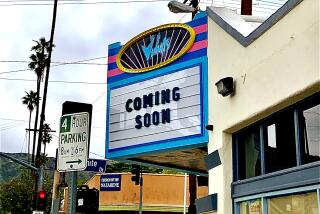Old New Town Finally to Get Downtown : Commercial Center Planned for Innovative Community
- Share via
RESTON, Va. — Before there was an Irvine, a Mission Viejo, a Woodlands, Tex., a Columbia, Md., a Valencia or a Westlake Village, there was a Reston.
This pioneering new town in the rolling and wooded Fairfax County countryside 18 miles west of Washington owes its character to the vision of New Yorker Robert E. Simon, who wanted to recreate in a brand-new planned community the kind of city life he experienced in Manhattan.
Simon achieved his goals in many ways, but not in the most visible: Reston lacks a central commercial core, a true downtown area.
This is being remedied with the 85-acre Reston Town Center mixed-use development in the 460-acre parcel that has long been designated on official maps as the commercial heart of the community.
The town center that was announced earlier this year will be similar in concept to Costa Mesa’s South Coast Plaza area, with hotels, shopping, theaters and other elements of a traditional downtown, albeit in an undeniably suburban setting, according to George J. Pillorge of RTKL Associates Inc., the architects of the center.
Construction Scheduled
Construction is scheduled to begin early next year on the town center, to be developed for Reston Land Corp. by Himmel/MKDG (Miller, Klutznick, Davis & Gray) Co. of Boston and Chicago.
Himmel/MKDG developed Boston’s Copley Place and Chicago’s Water Tower Place and is developing Denver’s City Center, according to Kenneth A. Himmel, a principal of the joint venture.
“We’re not going to build a sterile pedestrian mall,” he said. “This will be a true mixed-use urban center, with controlled auto traffic, plenty of parking, 300,000 square feet of retail space, 1,200 hotel rooms, 2.4 million square feet of office space and 600 to 800 residential units.”
Unlike many other new towns that planned and built their commercial cores or “downtowns” early in the development process and went on to build residential areas, Reston has developed around five village residential centers, each with its own relatively small-scale shopping facilities.
Wanted a Downtown
Simon, who was associated with Reston from 1961, when he purchased almost 7,000 acres, to 1967, when he was ousted by new owner, Gulf Oil, wanted a downtown.
In the innovative 1962 master plan adopted by Fairfax County for his development, there was to be a 150-acre downtown core--complete with high-rise buildings--to be developed in the early 1970s.
The nearest Simon got to high-rise buildings while he was still associated with Reston was the 15-story Heron House apartment building on the shores of Lake Anne, part of the much-photographed original village of Lake Anne.
Slow housing sales and subsequent changes in ownership and management--the development is now owned by Reston Land Corp., a unit of Mobil Oil--resulted in a change from high-density housing to more typical suburban housing, most notably single-family houses on fairly large lots.
Although it is an unincorporated part of Fairfax County, Reston abounds in community spirit, exemplified in a form of a powerful shadow government called the Reston Home Owners Assn. or RHOA is it is universally called.
Industrial Integration
In addition to the lakes and recreational amenities, Reston has contributed the concept of pedestrian walkways to the new town genre. An innovation that has not been widely copied, at least in California’s new towns, is the integration of industrial areas into residential ones, enabling many residents to walk to work.
Reston has attracted the kind of high-tech industries that also abound in Westlake Village, Irvine, Warner Ranch and Santa Clara County. Sperry Corp., Tandem Computers, AT&T;, IBM, Honeywell and Automata are some of the high-tech firms that contribute to the total of 23,000 jobs in Reston.
About a third of the people who live in the community work there, with most of the rest commuting to Washington, a spokesman for Reston Land Corp. said.
Available housing ranges from apartments and small condominiums priced under $60,000 to custom homes in the $400,000 and up range. When fully developed in the middle of the 1990s, Reston is expected to have a population of 62,000, up from about 47,000 now.
About that name: “Reston” was created from the initials of founder Robert E. Simon, along with the short form of “town.”
More to Read
Inside the business of entertainment
The Wide Shot brings you news, analysis and insights on everything from streaming wars to production — and what it all means for the future.
You may occasionally receive promotional content from the Los Angeles Times.










